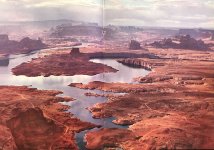JFRCalifornia
Keeper of San Juan Secrets
So I found the 1953 Gunsight Butte USGS 1:62500 quad, and its a great map showing the pre-dam river in the vicinity of where the movie was filmed, with the Crossing of the Fathers clearly marked at the mouth of Kane Wash. But nowhere is there a hint of a road that leads there, or to Alstrom Point for that matter. I've attached the quad.If you look very carefully on Google Maps / Earth at the Sand Hills bench area south of Alstrom Point and Romana Mesa between Warm Creek and Gunsight Canyons you can see the vestiges of a road. I've seen mention of a road to Kane Wash near Crossing of the Padres, but have not found any maps showing that pre-lake road. (The best old map that I have is a 1954 1:250,000 "Escalante" topo map covering a large portion of that area, long before Page, highways to Bullfrog, Lake Powell, and so forth.) There must have been some kind of road to bring in all of the equipment for Greatest Story Ever Told. My best guess is that it came down Crosby Canyon (current road), crossed Warm Creek, and then continued on the low bench level to the Kane Wash area. Any really old timers have any information about that, or the isolated road segment on the Sand Hills below Romana Mesa?
But then I came across a great photo from the January 1964 Arizona Highways, which was dedicated entirely to promoting the brand new Lake Powell. I'll have to do a whole post on that magazine spread, which is even more impressive than the 1967 National Geographic because it's 48 pages of recording the first impressions of Lake Powell (plus Glen Canyon Dam and Page too), and most importantly captures dozens of photos of the lake from the summer of 1963, when the lake was just starting to fill, and probably still somewhere in the 3300-3370 range.
Anyway, I'm attaching one 1963 photo taken over Padre Canyon looking toward Padre Butte and beyond while the lake is just starting to fill, but the future Padre Bay has not yet become Padre Bay. Still looks like a river. (By the way, this photo gives you a good idea of what “Dead Pool” at Lake Powell would look like, since it’s taken somewhere close to 3370, which is dead pool.)
What is clear in the photo is the there is indeed a pretty good looking road winding along the bench above the river/lake, and that's undoubtedly the one used to access the movie set...and for that matter had to be the way in and out once they diverted boat traffic off the river at Kane Wash in the years just before the dam was completed. They must have built that road after the 1953/54 USGS maps, but it didn't last long: that road disappeared under the lake in pretty short order...


Last edited:
